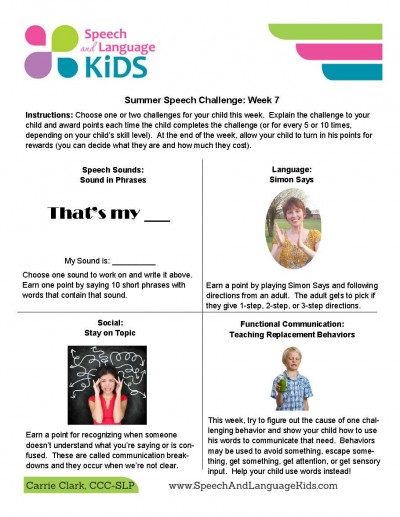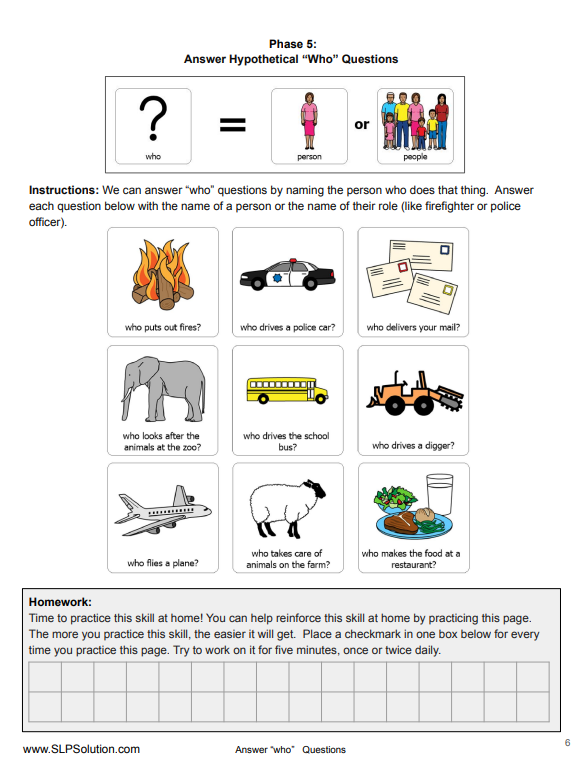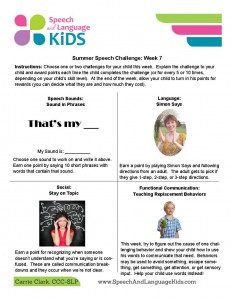Summer Speech Therapy Homework – Week 7
Welcome to week seven of our Summer Speech Challenge for Parents! Click here if you want to go back and start from week 1!
Summer Speech Therapy Homework Challenge:
To recap, our Summer Speech Challenge is a new challenge for your child each week of this summer. These are simple activities that are meant for you to be able to work into your daily routines. There are four different challenges each week so you can pick which one is best for your child. If you feel like your child struggled with last week’s and you’d like to try it for another week, go for it! Or, you can push ahead and do this week’s activity anyway. Sometimes our children do better if we switch to something else.
Avoid the Battle:
I want to make a quick note here that nothing we’re doing here should be a battle! If your child is struggling to do the skill that you’ve selected, try to either make it easier or switch to something else. The reason that we speech-language pathologists go to school for 5+ years is so that we can know exactly how to tweak things when the child isn’t getting it. So don’t feel bad if it’s just not clicking for you and your child! Switch to something a little easier to keep the momentum going and check in with your child’s speech-language pathologist. This shouldn’t replace the advice of a licensed speech-language pathologist!
Choose an Area:
You’ll want to pick one or two challenges for your child to work on this week. Here’s a quick breakdown of the 4 areas that are included in our summer challenge so you can pick which skills your child needs.
- Speech Sounds: Choose this area if your child is struggling to say a sound correctly in conversation. You’ll only choose one sound to work on at a time so don’t go crazy! You can always come back and repeat this process with another sound later.
- Language: Choose this area if your child struggles with any parts of language. This can include anything from using full, grammatically-correct sentences to knowing the names for different vocabulary words. If it has to do with putting together sentences and getting your ideas across using words, then language is your area.
- Social Skills: Choose this area if your child needs help with interacting appropriately with others. We’ll practice a variety of interaction skills with this area.
- Functional Communication: Choose this area if your child is just beginning to talk or is only saying 1-2 words at a time. This area will focus on basic communication skills for our non-verbal children and new talkers.
Challenge Week 7:
Let’s get started with this week’s challenge!
Instructions:
- Choose one (or max two) areas below that your child needs to work on
- Print out the visuals for the challenges and cut out the ones your child needs
- Post the visuals somewhere so you and your child will see it frequently
- Read the challenge rules and explain it to your child in language she will understand
- Award points as your child completes the challenge throughout the week (view week 1 for ideas for this)
- Allow your child to redeem points as you see fit
Week 7 Picture Download:
Click Here to Download the PDF
The Challenges:
Speech Sounds: Sound in Phrases
For the speech summer challenges, you’ll want to choose one sound to work on. It gets complicated when you start adding in multiple sounds so just choose one that your child needs to work on. It can be one he’s already been working on in speech or an entirely new one.
You’ve been working with your child this summer on saying his target sound in single words. Now we’re finally ready to move up to short phrases! Keep in mind that if your child was struggling with single words, you’ll want to keep working on that until he makes some more progress.
Once he’s doing well at using the target sound in single words, try having him come up with some short phrases to put those words in. I like to start with the same phrase over and over again when we’re just starting this. You could have your child say “that’s my ___” and then say a word that starts with the sound. Once he starts getting better at this, you can have him come up with his own 2-3 word phrases. Tell him a word and have him say it in a phrase. Your child will earn 1 point for every 10 phrases he says with his target sound.
Why This Helps: Now that your child can say the sound in single words, it’s time to bump it up to phrases! He may not yet be able to say the sound in normal conversation so this gives him some practice saying the sound correctly in slightly longer utterances than single words.
Language: Simon Says
This week, your child can earn a challenge point for playing Simon Says with you! With this game, you’ll say “Simon Says…” and give your child a direction. Then, your child will follow the direction. The point of the game is that the child is only supposed to follow the direction if you say “Simon Says”. If you just give the direction without saying “Simon says”, then the child isn’t supposed to follow it. If you’re working with a younger child, I suggest you just always say “Simon says” and leave out the part where you try to trick her.
For this activity, try to think about what types of directions your child generally struggles with. Can she follow one-step directions like “sit down” or “go get your shoes”? Can she follow two-step directions like “come here and sit down” or “go to your room and grab your cup”? Or maybe, she’s working on 3-step directions! Try to figure out which level your child struggles with and give directions at that level. You can just to use common directions that she might hear in her everyday life (like, “go sit at the table”) or novel directions (like, “clap your hands and then touch your nose”).
Why This Helps: Our children are expected to follow directions all day long at both home and school. Practicing listening to directions and following through in a fun way (like “Simon Says”) can help your child get better at following them when she hears them. Of course, selective hearing is a whole other issue…!
Social Skills: Identify a Communication Breakdown
Have you ever been having a conversation with someone and then realized that you were both talking about two different things? Or that one of you didn’t understand what the other was talking about? That’s called a communication breakdown and as adults, we’re pretty good at recognizing when those have happened and repairing them. Our children with social language problems tend to struggle with this skill.
This week, award your child a point every time he recognizes a communication breakdown. Start off by explaining the signs to look for when someone is confused or doesn’t know what you’re talking about. These include things like: looking confused (look at pictures on Google image search to find examples), looking bored/uninterested, saying something that doesn’t make sense with what you just said, asking questions, etc.
To practice this skill, have a conversation with your child and at some point, pretend that you don’t understand. Show your child the same signs that you just talked about (looking confused, saying something that doesn’t go along with what he said, etc.). At first, you may have to point out to your child that you’re showing the signs. Keep practicing this until your child gets better at seeing the signs himself.
Why This Helps: Being able to see when a breakdown has occurred can help our children with social language impairments get the conversation back on track and keep their social interactions strong.
Functional Communication: Replace a Challenging Behavior
This week, you’re going to choose one challenging behavior that your child has and see if you can find a good replacement behavior/communication. Think about one behavior that your child does that causes problems. It could be hitting, throwing, tantruming, etc. Try to narrow it down as much as you can by choosing just one situation that causes that behavior. For example, you might choose tantrums but you could narrow it down to “tantrums/throwing food when she decides she’s done at the dinner table”.
Determine what the cause of this behavior is. Keep in mind that this can be tricky and sometimes it helps to have an outside person or even a behavior specialist to figure out the cause of the behavior. If you can’t figure it out with this specific situation/behavior, choose another one that you think you know why it’s happening. Here are the 5 choices for functions for a child’s behavior:
- Escape: to get out of something
- Avoidance: to avoid something that’s coming
- To Get Something: to get a tangible item like a candy bar at the grocery store checkout
- To Get Attention: because the child likes the attention she gets as a result of the behavior
- Sensory: the behavior helps the child feel good or the behavior itself is rewarding for the child
Once you think you know the cause, try to think of an alternative way for your child to communicate that need to you. Here are some ideas:
- Escape: Place a picture of an “x” next to your child and tell her it’s her break card. When she wants to be done with something, help her point to the card and say “I need a break” or just “break”. If your child isn’t talking yet, you can help her point to the break card and say “break” for her. Then, let her be done with the activity. The next time, watch for signs that she seems like she’s about to be done and remind her, “If you need a break, you can point to your break card”.
- Avoidance: If there is something coming and your child doesn’t want to do it (like leave the playground), give your child the choice of doing it now or in two minutes. Help your child say “two” or “two minutes please”. If your child isn’t talking yet, you help her hold up two fingers or sign the word “wait” (hold both hands out in front of you, palms up, and wiggle your fingers). Then, tell your child that you will wait two minutes but then she will have to do the thing after that (if it’s something that absolutely must be done). She may still have challenging behaviors the second time but you’re teaching her to communicate what she wants and that can be very powerful!
- To Get Something: Prompt your child to use words to ask for the thing she wants. If it is something that you can give your child, give it to her after she uses words. If your child isn’t talking yet, teach her some sign language signs for what she wants. If it is something that you can’t give your child, try to find an alternative and help her ask for that. For example, if she can’t have the candy at the checkout, offer her a favorite food when she gets home.
- To Get Attention: If your child is acting up to get attention, teach your child how to ask for a hug or a high five. Your child can use words or sign language to get this done. When your child starts to act up, prompt your child to ask for a hug or high five by saying “Do you need a hug? How do we ask?”
- Sensory: If your child is engaging in challenging behaviors because she likes the way it feels (like throwing toys because she likes the feeling of throwing things), find a safe/less disruptive way for the child to get that same sensory need met and teach her to ask for it. For example, if your child is throwing toys, explain that if she needs to throw something, she can throw a beanbag in a bucket (or whatever else you have that you could set up for her). Then, help her either say or sign the words to ask for that activity.
Why This Helps: Behavior is communication. When our children act up, they are telling us something. Our children with language delays often use challenging behaviors to communicate with us since their words aren’t always very effective. The more you can practice decoding what your child’s behavior is trying to tell you, the better you’ll get at it. Seek some help from your speech-language pathologist on this. We usually have great ideas of how we can teach a child to communicate something without challenging behaviors!
Recap:
OK, you should have your challenge(s) by now. Here’s a recap of what you need to do:
- Print out the pictures for this week’s challenges and cut out the ones you need (see button below)
- Post the challenge picture on the wall and explain the challenge to your child
- Award points throughout the week whenever your child completes the challenge
- Encourage your child to practice and earn points as often as possible

About the Author: Carrie Clark, MA CCC-SLP
Hi, I’m Carrie! I’m a speech-language pathologist from Columbia, Missouri, USA. I’ve worked with children and teenagers of all ages in schools, preschools, and even my own private practice. I love digging through the research on speech and language topics and breaking it down into step-by-step plans for my followers. I graduated from Truman State University in Kirksville, MO with a masters degree in Communication Disorders.
Connect with Me:









I love this idea of a weekly simple activity for my students to work on over the summer! It’s also easy and quick that it won’t overwhelm the parents or students.
Thanks for sharing,
Melissa
Speech Therapy Store
We did, too! Glad this will be of help to you, Melissa!
A great and fresh idea in your post. I will also take part in these challenges myself.
All of the information you put in your post is good and can be very helpful. I’ll remember it. Thanks for sharing the information. Please keep posting new information
Nice post
Impressive variety! Your ability to cover different subjects while maintaining quality is commendable.
Find the level where your child is having the most trouble and give them instructions at that level.
I like how your posts are full of useful information
Success! It may be one of the most useful blogs we have come across on the subject. Great information! I am also an expert in this subject so I can understand your efforts very well. Thanks for the great help.
Thanks for sharing,
amazing
good information!
Encouraging flexibility by adjusting tasks based on the child’s progress will help prevent frustration and keep the child motivated.
You’ve opened a window of opportunity for me with your advice—now I can see possibilities I never considered before